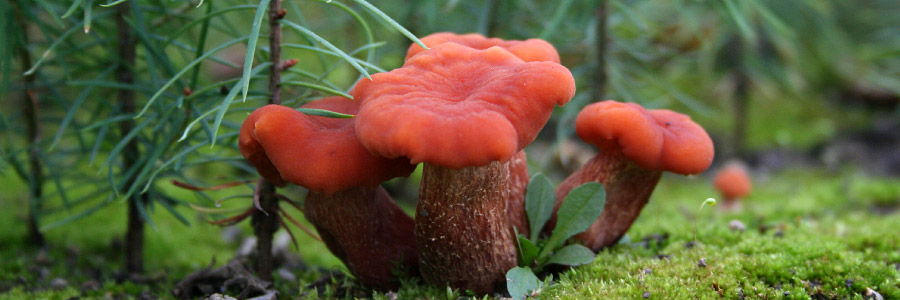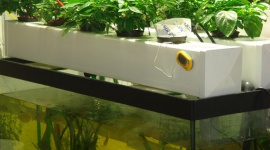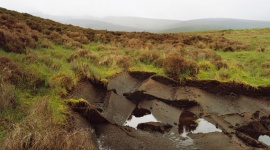Fungus: kingdom of the fluffies
By D. Kroeze MSc., CANNA Research
Concerning fungi in crops
Grey mould (Botrytis), mildew or Pythium: everyone has heard of these at some stage. They are not just diseases that can attack plants, they are also fungi. But what exactly are fungi? And do all fungi make plants sick?
What is a fungus?
We can try to classify the organisms that live on our planet into groups. How many groups are needed to do this has still to be agreed upon by scientists. But in practice, it seems that living organisms simply don’t fit into slots perfectly since there are always exceptions to established criteria and new insights into the criteria themselves. The classification is currently being reviewed again. However, there are three groups that have been established for a long time. These groups, or better said, kingdoms, are animals, plants, and fungi. Other organisms such as bacteria still have no definitive categorisation.
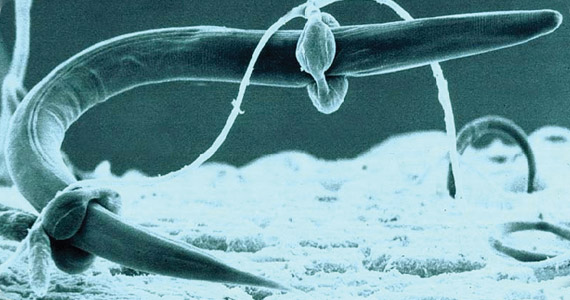
A fungus on the hunt. It catches the nematode with its lasso and then eats it slowly.
The fact that fungi are a separate group means that they also have specific characteristics. Plants and fungi were previously categorised in the same group. The main difference between plants and fungi is that fungi have no chlorophyll. Another difference is the cell wall of fungi, which, in contrast to that of plants, is made from chitin. Once nutrients have been broken down by the enzymes that the fungus secretes, they are absorbed through the cell wall.
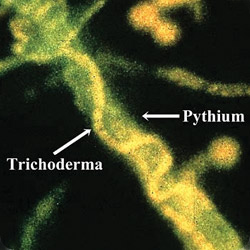
The parasitic Pythium fungi caught by the
Trichoderma fungi.
Photos : American Phytopathological Society
Fungi can provide for their own nutritional needs in different ways. There are fungi that have cohabitation (symbiotic) contacts with other organisms. Many fungi live together with trees, for instance. Their reproductive organs are well known; they are the mushrooms in the woods. The fungi get sugars from the trees in exchange for certain nutrients.
Another important group is what is known as the saprophytes. These are our planet’s waste disposal system. They live on dead material, such as fallen leaves. Then there are the parasites that live at the expense of other organisms. These fungi are by far the most responsible for the majority of diseases encountered in agricultural crops. Finally there is the group of predators, which is the least well-known group of fungi.
Predators hunt other organisms. There is a type of fungi that hunts nematodes and strikes by using traps. After the trap is sprung, the fungus grows into the nematode and digests it. Another, somewhat better known example is the Trichoderma fungi family. These fungi attack what are known as damping-off diseases which are parasitic fungi that target germinated seeds or very young plants in particular. Trichoderma occurs naturally in coconut fibre among other things. Coconut fibre is generally steamed which kills the fungi; however, coconut fibre that hasn’t been steamed is also available.
Parasitic fungi in plants above ground level
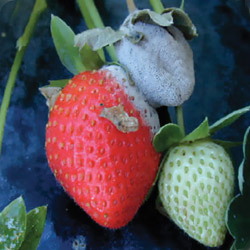
Grey fungi on strawberries.
A dreaded fungal disease in horticulture is caused by the grey fungi (Botrytis sp.). The grey fungus is parasitic but can also live as a saprophyte. It certainly isn’t choosy and has a lot of agricultural crops on its menu. A well-known example of this is the strawberry where it can often be seen as a grey fluff. A pink rot (Trichothecium roseum) infection sometimes resembles a grey fungus infection very closely. It is only under a microscope that the differences become clear.
A white powder is sometimes found on plants’ leaves. This is mildew which is a different parasitic fungus. If the fungus is on the upper side of the leaf, then it is genuine mildew, but if it is on the underside it is what is known as false mildew. This is often confused by many growers.
Mildew can be caused by many different fungi and is generally plant specific. Mildew on cucumber is caused by Sphaerotheca fusia and not by Uncinula necator, the fungus afflicting grapes. False mildew is caused by Pseudoperonospora cubensis and Plasmopora vitícola respectively. High humidity is generally ideal for fungus growth. In contrast with most other fungi, spores of genuine mildew only germinate well on dry leaves.

Fungi on an apple: Botrytis or Trichothecium?
The microscope provides the answer: (2) Botrytis cinerea and (3) Trichothecium roseum.
Photo left: Ministry of Agriculture and Lands, Canada, photo centre: CABI Bioscience and photo right: University of Adelaide
How an infection develops
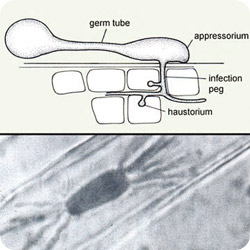
Systematic representation of a plant cell being
penetrated by a germinated fungus spore.
Illustration: University of Hertfordshire
If the leaf environment is ideal, and this includes the correct humidity and temperature, a spore that lands on the surface of a leaf can germinate. A filament grows from the spore which enters the plant via a wound or stoma and then swells up.
Once the filament is inside it swells up again and these swellings are used to extract nutrients from the plant cells. Following this, more filaments with swellings are formed. In addition, the fungus forms reproductive organs, which distribute new spores into the air without sex, or asexually. This is how the infection cycle begins.
Attacks below ground level
Parasitic fungi do not just attack parts of plants that are above the ground. Fungi also attack from inside the growing medium. These notorious villains are grouped under the ‘damping-off’ name and have imaginative names such as Pythium, Rhizoctonia, Fusarium and Phytophthora. The grey fungi and a number of others also belong to this group. It is these fungi that have the ‘cot death’ of plants that have just rooted and the demise of newly germinated seeds on their conscience.
Tips against damping-off diseases
- Spores on seeds can be killed by soaking the seeds that are to be germinated in a solution of bleach (one part bleach to nine parts water) for two minutes. After this rinse well preferably using water that has been boiled and then cooled.
- Place seeds to be germinated on the surface of the growing medium and then cover them with a thin layer (three or four times the thickness of a seed) of an inorganic medium such as perlite.
- Do not use soil from outside for indoor cultivation.
- Do not use garden tools inside that are also used outside.
- Clean gardening tools and pots well after use and disinfect them with a bleach or alcohol solution.
- With a protected crop, ensure that there is constant ventilation, and make sure the ventilator isn’t turned off via the lighting timer.
- Avoid giving too much water and allow the medium to dry out a little before giving more water.
- Do not use rainwater.
Summing up
Fungi are classified into their own kingdom as are plants and animals. We actually only know the fungi that we encounter and this is a very small proportion of those that exist. Unfortunately, many of the fungi we know are pathogenic for our plants so it is necessary to protect our plants against them. You should ensure that your plants get a good start by preventing damping-off diseases. Also, make sure that later on in the growing cycle there is sufficient ventilation and avoid excessive humidity. Taking these measures will hamper the distribution of fungi spores. But… keep in the back of your mind the fact that insufficient humidity can also cause problems, such as encouraging spider mites.
